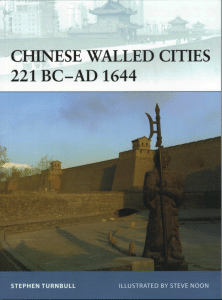Review: Chinese Walled Cities 221 BC-AD 1644 from Osprey Publishing
Chinese Walled Cities 221 BC-AD 1644 by Stephen Turnbull is a recent release from Osprey Publishing that continues their line of fortress reference books. 
A clarification is required of the term “review” before I continue with this post. Osprey Publishing publishes many titles every year and has done so for decades. There is a small army of professional illustrators, editors and history professors working behind the scenes to create all of this content. Osprey has a niche and totally focuses on producing quality product for that niche. They are quite good at it. In a normal review (especially for game companies) on Livingdice.com, I take a close look at production quality, editing, and art in addition to the actual content. Doing so with an Osprey book is a waste of time. As a company, they are simply too practiced at what they do to make frequent editing mistakes or put bad art into a book. That is not to say I will ignore these aspects, but I will not mention them unless they are significantly deficient.
Rather I would like to focus on the book’s content and how that content can inform or enhance your game’s reality and depth. I am not a historian, so I am not qualified to comment on the quality of the book’s research, but as a long-time gamer I am qualified to discuss if a book is a good resource for game campaign design.
Enough boilerplate, time to actually talk about the book.
I know this is a “serious” reference book, but there was a line in the first chapter that made me chuckle.
“Chinese city walls saw a lively operational history…”
“Lively operational history” is the best euphemism for “centuries of unrelenting and bloody war” I have heard to date. I sense some great game material to come…
Even though the book has chapters, I broke it down into two distinct sections. The first section comprises about 38 of the 84 pages and is truly dedicated to Chinese city walls. It discusses in great detail the designs and construction techniques in making city walls. You pick up some useful information like many city walls were basically rammed earth with a brick facing. There is also some historical context mixed in, as well as some discussion about the principles of defense in ancient China. A surprise for me was the total lack of interior defenses in the cities, relying on the city walls as the sole means of defense. I have the European “walled city with citadel” model burned into my brain as the standard city defense design. Apparently the Chinese felt differently and simply did not build the citadel.
This section also contains a survey of the great walled cities of China and their ruins or in a few cases, surprisingly intact walls.
I think as some background material, the first section might provide some “flavor” for your campaign, but the real gaming goodness is in the latter part of the book after page 39. This section actually discusses specific sieges, combat tactics and personalities involved. Here are a few highlights:
- A defending general ordered his men to eat his favorite concubine to demonstrate that everyone must sacrifice during an extended siege
- Organizational structure of city fire-fighting brigades
- Methods of gunpowder storage
- Counter-mining techniques and sappers
- An attacking general that tried to hold the defending general’s son hostage, only to have the boy’s father shoot arrows at his own son in an attempt to kill him and “end” the hostage situation
- Wheeled, spiked “sweepers” that ran up and down a wall to clear it of attackers
- Stopping a battering ram with curtains
- Generals were often concerned that their own people would revolt during the siege
- Details on how the walls were manned by soldiers, including how they ate, slept and generally lived during the siege
- Using the latrine as a weapon
My personal favorite is an anecdote that an attacking general sent a message by arrow into a city offering a bounty for anyone that betrayed the defending city and killed their general. The defending general promptly took the message, wrote a similar offer on the back of the note for the attacking general’s head and sent it back. Almost as good as saying “Nuts” when you are surrounded by the Nazis!
Chinese Walled Cities 221 BC-AD 1644 starts out slow, but it has some great material for the patient campaign designer and is most certainly worth a look.
Trask, The Last Tyromancer
Full Disclosure: Osprey provided a review copy of this book
How cool/useful are the maps of the cities?
There are some well-done maps of the cities, but the scale is so large that all you can really see is the wall design and the street layout.
Trask